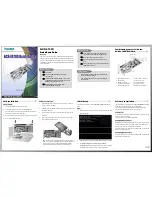
Installation Guide.
PC IEEE Reference
However, due to the large variety of add-on boards that
may be present in the PC, your PC IEEE board may need
tayloring to suit your setup.
The DIP Switches And Jumper Blocks.
__________________________________
The PC IEEE card has one 8 way DIP switch block, the
switches are clearly marked 1-8. DIPs 2-8 select the PC IEEE
card base address whilst DIP 1 is a don’t care switch. Make
certain that DIP 1 is set ON for compatibility with future
versions of the PC IEEE.
The PC IEEE card has an IRQ jumper block. This IRQ
jumper block, can be set to produce IRQ interrupt signals - such
as when an IEEE device asserts its Service Request line, SRQ,
to signal that it has data ready for the PC. There is no DMA
facility on the PC IEEE card, if your application requires DMA
then use the PC Elite IEEE interface.
The base address and IRQ options are communicated by
the user to the computer using the Professional 488 Device
Driver software or via your third party IEEE software using its
own set up or configuration routine.
It is worth noting that the standard PC IEEE cannot be
made to emulate the IBM or National Instruments GPIB board,
neither can it be set to i/o address 02E1h. If you must have a
board that emulates IBM’s please use the PC Elite IEEE
interface - contact your dealer for one.
The PC Elite IEEE i/o address map is identical to the IBM
GPIB and National Instruments GPIB PC2A board and it will
run ALL software that these boards run. IBM’S GPIB, N.I.’S
PC2A, the PC IEEE and the PC Elite cards can all co-exist
happily in the same computer provided that they are set to
different i/o addresses.
Setting The I/O Address.
______________________
By referring to the PC IEEE card locate the I/O Address
Chapter 2
Page 11
















































